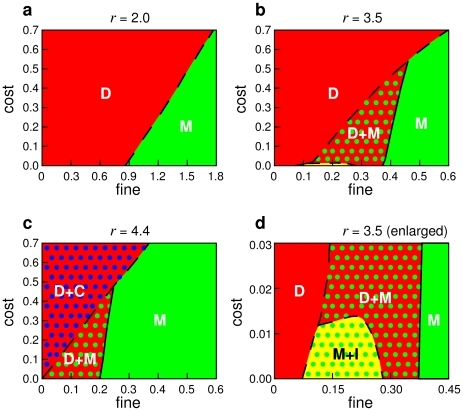Figure 1. Phase diagrams showing the remaining strategies in the spatial public goods game with cooperators (C), defectors (D), moralists (M) and immoralists (I), after a sufficiently long transient time.
Initially, each of the four strategies occupies 25% of the sites of the square lattice, and their distribution is uniform in space. However, due to their evolutionary competition, two or three strategies die out after some time. The finally resulting state depends on the synergy  of cooperation, the punishment cost
of cooperation, the punishment cost  , and the punishment fine
, and the punishment fine  . The displayed phase diagrams are for (a)
. The displayed phase diagrams are for (a)  , (b)
, (b)  , and (d)
, and (d)  . (d) Enlargement of the small-cost area for
. (d) Enlargement of the small-cost area for  . Solid separating lines indicate that the resulting fractions of all strategies change continuously with a modification of the model parameters
. Solid separating lines indicate that the resulting fractions of all strategies change continuously with a modification of the model parameters  and
and  , while broken lines correspond to discontinuous changes. All diagrams show that cooperators cannot stop the spreading of moralists, if only the fine-to-cost ratio is large enough. Furthermore, there are parameter regions where moralist can crowd out cooperators in the presence of defectors. Note that the spreading of moralists is extremely slow and follows a voter model kind of dynamics [46], if their competition with cooperators occurs in the absence of defectors. Therefore, computer simulations had to be run over extremely long times (up to
, while broken lines correspond to discontinuous changes. All diagrams show that cooperators cannot stop the spreading of moralists, if only the fine-to-cost ratio is large enough. Furthermore, there are parameter regions where moralist can crowd out cooperators in the presence of defectors. Note that the spreading of moralists is extremely slow and follows a voter model kind of dynamics [46], if their competition with cooperators occurs in the absence of defectors. Therefore, computer simulations had to be run over extremely long times (up to  iterations for a systems size of
iterations for a systems size of  ). For similar reasons, a small level of strategy mutations (which permanently creates a small number of strategies of all kinds, in particular defectors) can largely accelerate the spreading of moralists in the M phase, while it does not significantly change the resulting fractions of the four strategies [51]. The existence of immoralists is usually not relevant for the outcome of the evolutionary dynamics. Apart from a very small parameter area, where immoralists and moralists coexist, immoralists are quickly extinct. Therefore, the 4-strategy model usually behaves like a model with the three strategies C, D, and M only. As a consequence, the phase diagrams for the latter look almost the same like the ones presented here [58].
). For similar reasons, a small level of strategy mutations (which permanently creates a small number of strategies of all kinds, in particular defectors) can largely accelerate the spreading of moralists in the M phase, while it does not significantly change the resulting fractions of the four strategies [51]. The existence of immoralists is usually not relevant for the outcome of the evolutionary dynamics. Apart from a very small parameter area, where immoralists and moralists coexist, immoralists are quickly extinct. Therefore, the 4-strategy model usually behaves like a model with the three strategies C, D, and M only. As a consequence, the phase diagrams for the latter look almost the same like the ones presented here [58].

